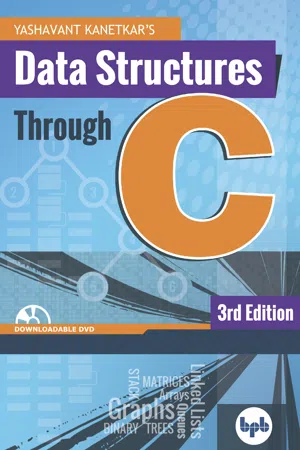
Data Structures Through C
Learn the fundamentals of Data Structures through C
- English
- ePUB (mobile friendly)
- Available on iOS & Android
About this book
Experience Data Structures C through animationsThere are two major hurdles faced by anybody trying to learn Data Structures: Most books attempt to teach it using algorithms rather than complete working programsA lot is left to the imagination of the reader, instead of explaining it in detail. This is a different Data Structures book. It uses a common language like C to teach Data Structures. Secondly, it goes far beyond merely explaining how Stacks, Queues, and Linked Lists work. The readers can actually experience (rather than imagine) sorting of an array, traversing of a doubly-linked list, construction of a binary tree, etc. through carefully crafted animations that depict these processes. All these animations are available on the downloadable DVD. In addition it contains numerous carefully-crafted figures, working programs and real world scenarios where different data structures are used. This would help you understand the complicated operations being performed an different data structures easily. Add to that the customary lucid style of Yashavant Kanetkar and you have a perfect Data Structures book in your hands. KEY FEATURES• Strengthens the foundations, as detailed explanation of concepts are given • Focuses on how to think logically to solve a problem• Algorithms used in the book are well explained and illustrated step by step.• Help students in understanding how data structures are implemented in programs. WHAT WILL YOU LEARN• Analysis of Algorithms, Arrays, Linked Lists, Sparse Matrices• Stacks, Queues, Trees, Graphs, Searching and Sorting WHO THIS BOOK IS FORStudents, Programmers, researchers, and software developers who wish to learn the basics of Data structures.AUTHOR BIOYashavant Kanetkar Through his books and Quest Video Courses on C, C++, Java, Python, Data Structures,.NET, IoT, etc. Yashavant Kanetkar has created, molded and groomed lacs of IT careers in the last three decades. Yashavant's books and Quest videos have made a significant contribution in creating top-notch IT manpower in India and abroad. Yashavant's books are globally recognized and millions of students / professionals have benefitted from them. Yashavant's books have been translated into Hindi, Gujarati, Japanese, Korean and Chinese languages. Many of his books are published in India, USA, Japan, Singapore, Korea and China. Yashavant is a much sought after speaker in the IT field and has conducted seminars/workshops at TedEx, IITs, IIITs, NITs and global software companies. Yashavant has been honored with the prestigious "Distinguished Alumnus Award" by IIT Kanpur for his entrepreneurial, professional and academic excellence. This award was given to top 50 alumni of IIT
Frequently asked questions
- Essential is ideal for learners and professionals who enjoy exploring a wide range of subjects. Access the Essential Library with 800,000+ trusted titles and best-sellers across business, personal growth, and the humanities. Includes unlimited reading time and Standard Read Aloud voice.
- Complete: Perfect for advanced learners and researchers needing full, unrestricted access. Unlock 1.4M+ books across hundreds of subjects, including academic and specialized titles. The Complete Plan also includes advanced features like Premium Read Aloud and Research Assistant.
Please note we cannot support devices running on iOS 13 and Android 7 or earlier. Learn more about using the app.
Information
Chapter 01
Analysis of Algorithms
Justifying the means
Why This Chapter Matters?
Why Analyze Algorithms?
What to Consider, What to Ignore?
Get the next character
Table of contents
- Cover Page
- Title Page
- Copyright Page
- Dedication
- About the Author
- Acknowledgements
- Contents
- Introduction
- 1. Analysis of Algorithms
- 2. Arrays
- 3. Linked Lists
- 4. Sparse Matrices
- 5. Stacks
- 6. Queues
- 7. Trees
- 8. Graphs
- 9. Searching And Sorting
- Index